On This Page
Elderberry Bushes Attract Backyard Birds
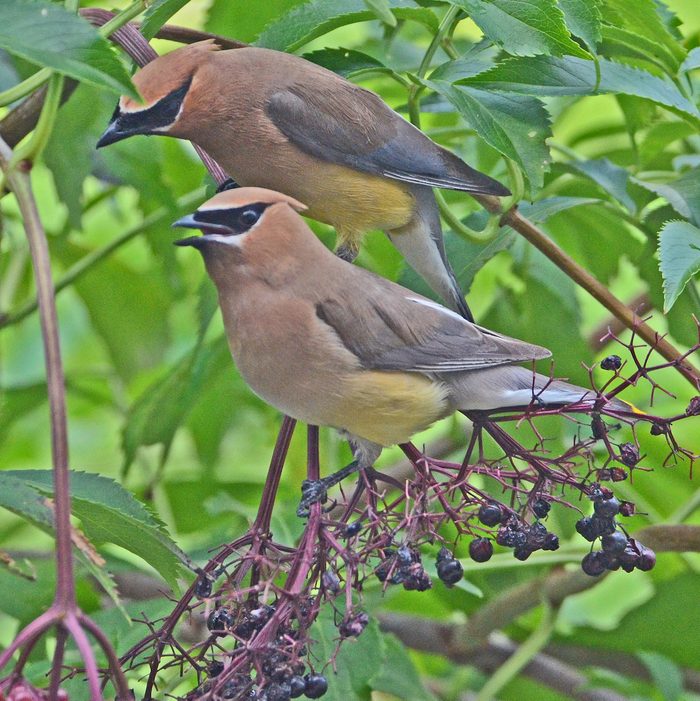
This one of our berry facts is for the bird lovers. One of the best ways to bring in birds to your backyard is to plant bushes with berries. Birds that don’t usually visit feeders—such as stunning cedar waxwings—will readily eat fruit. Elderberry shrubs are known to feed more than 30 bird species, such as cedar waxwings, northern mockingbirds and gray catbirds. Plus, they provide shelter and nest sites.
No space to grow a berry bush? Consider putting out grape jelly for fruit-eating birds.
Raspberries Are More Colorful Than You Think

You probably knew raspberries are red, but you probably weren’t aware that they come in more than one color. They’re also available in black, purple, and gold. Black raspberries tend to be smaller than the red variety typically sold in supermarkets, and they are primarily used for cooking.
When you’re done looking at berry facts, check out these fascinating facts about carrots.
Check Restrictions Before Planting These Berries
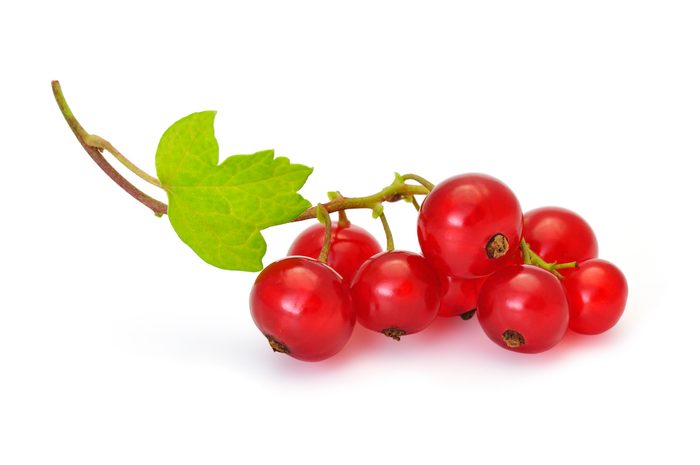
It was illegal to grow currants (shown above) and gooseberries in the U.S. until 1966. They were hosts to white pine blister rust, a fungus that destroys white pine trees. Some states still have restrictions in place. In those states, growing these berries may require a special permit.
Are American pokeweed berries poisonous?
You Can Grow Blueberries in Your Backyard
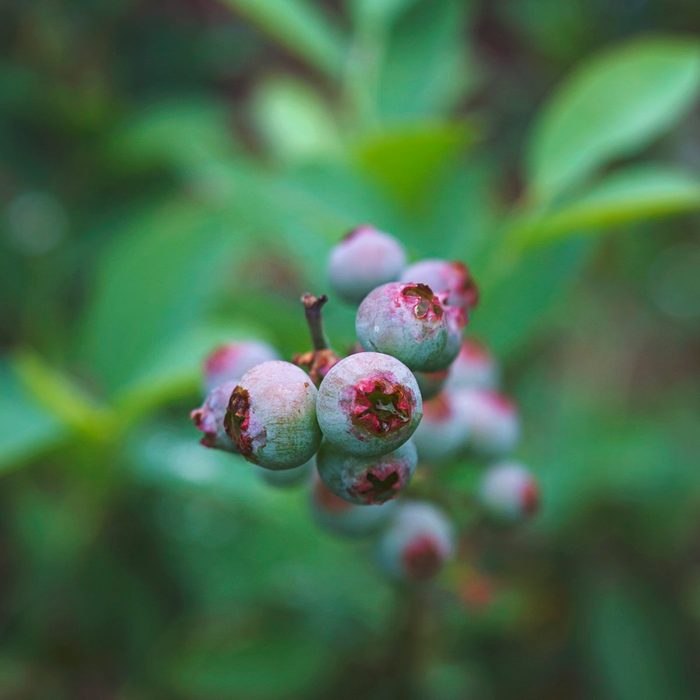
Put down the grocery-store blueberries! Growing these sweet fruits in your backyard is easier than you might think, but you need to make sure you have the correct growing conditions. Blueberries prefer soil as acidic as 4 to 5 pH. You may need to test your soil for guidance on adjusting your pH before you plant blueberries.
For more berry facts, check out our blueberry growing guide.
A Banana’s Technical Classification Might Surprise You
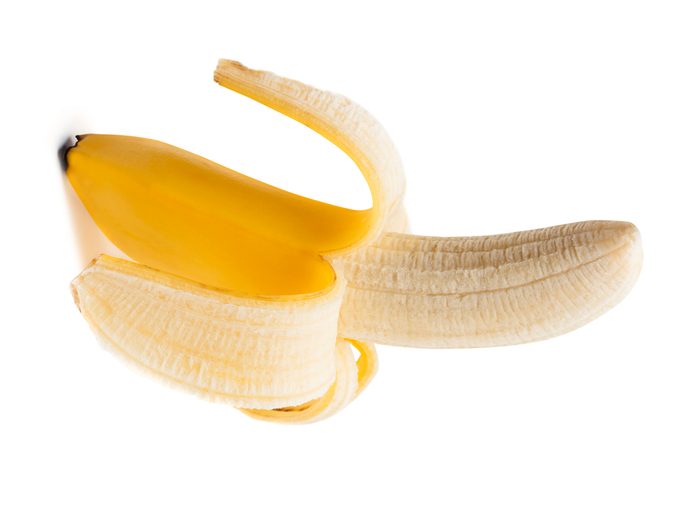
You’ve probably never thought of a banana as a berry, but it is one. Botanically, a banana is a berry because it is produced from an individual flower containing one ovary. Modern cultivars are seedless.
Grow brandywine viburnum for tie-dye berry clusters.
Cherries Are Not Berries
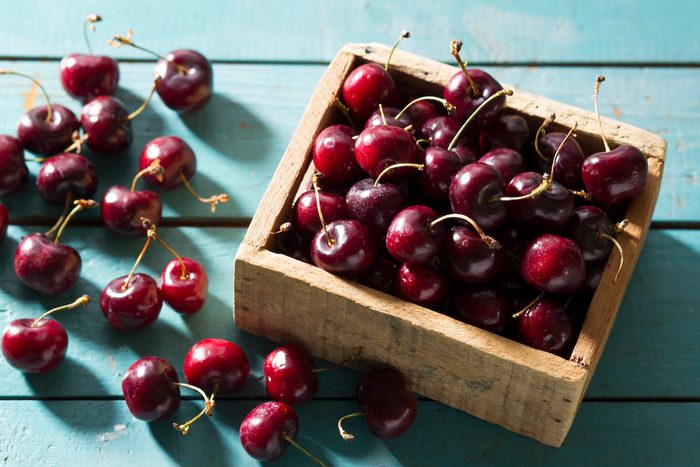
Equally surprisingly, despite their rhyming names, a cherry is not a berry—it’s classified as a stone fruit. Other types of stone fruits include peaches, plums and apricots.
Get expert tips on growing cherries.
Some Blackberries Don’t Have Thorns
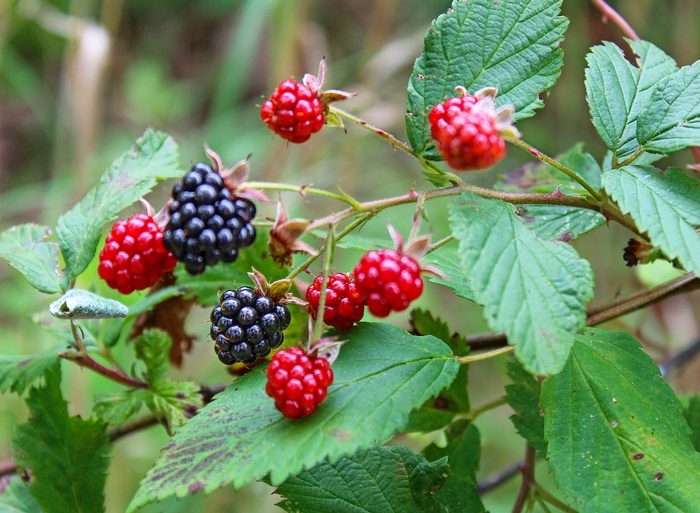
While they don’t have as many different colors as raspberries, blackberries still technically have two different forms: with or without thorns.
Next, learn how to grow a black chokeberry shrub.
Additional reporting by Emily Hannemann
Sources
Penn State Extension, “Raspberry Planting and Care for Home Gardeners”
Penn State Extension, “Brambles in the Home Fruit Planting”
Bur Oak Land Trust, “Elderberry: For the Birds”
University of Minnesota Extension, “Growing Stone Fruits in the Home Garden”
Stanford Magazine, “Bananas Are Berries?”
Why Trust Us?
For nearly 30 years, Birds & Blooms, a Trusted Media Brand, has been inspiring readers to have a lifelong love of birding, gardening and nature. We are the #1 bird and garden magazine in North America and a trusted online resource for over 15 million outdoor enthusiasts annually. Our library of thousands of informative articles and how-tos has been written by trusted journalists and fact-checked by bird and garden experts for accuracy. In addition to our staff of experienced gardeners and bird-watchers, we hire individuals who have years of education and hands-on experience with birding, bird feeding, gardening, butterflies, bugs and more. Learn more about Birds & Blooms, our field editor program, and our submission guidelines.
On This Page
Costa Rica Hummingbirds You Should Know
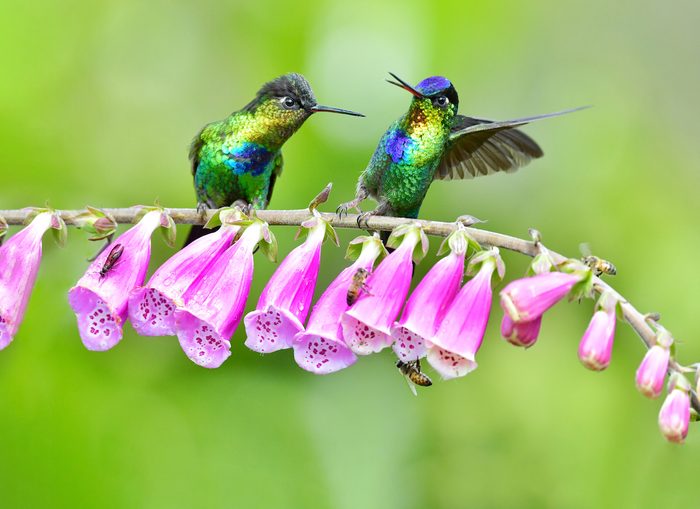
With their vibrant colors, hummingbirds seem as if they belong in the tropics—and they do. Fewer than 20 species of these little gems can be found found regularly in all of the United States and Canada. By contrast, the tiny, beautiful nation of Costa Rica—less than half the size of Ohio—hosts more than 50 hummingbird species. Here are a few favorites among the many types of hummingbirds that call Costa Rica home.
Volcano Hummingbird
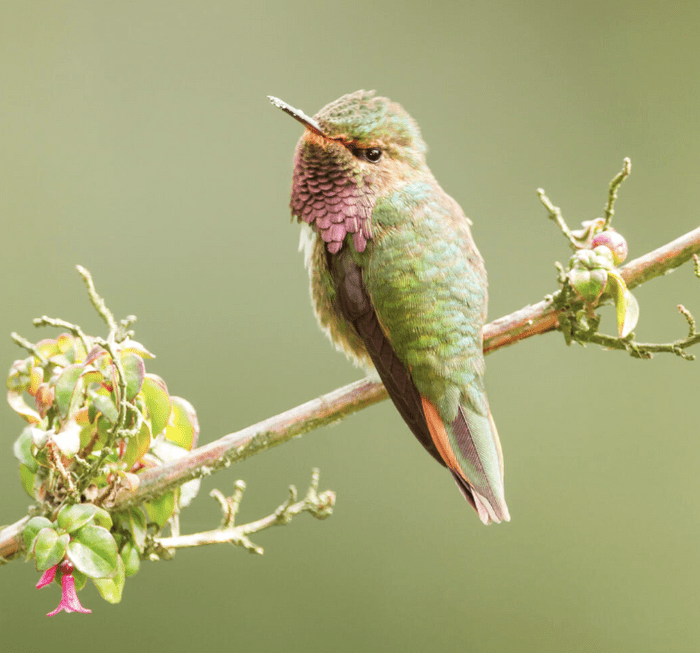
Related to the rufous hummingbird of North America, the volcano hummingbird is a very small species living only in Costa Rica and a small portion of western Panama. It’s a common resident in the high mountains, zipping about in open meadows and the edges of scrubby forests.
Adult males have bright iridescent colors on the throat. The exact color varies on different mountaintops. It varies from reddish to purple, blue-gray or green. On females, the throat is white with dark spots.
Fiery-throated Hummingbird
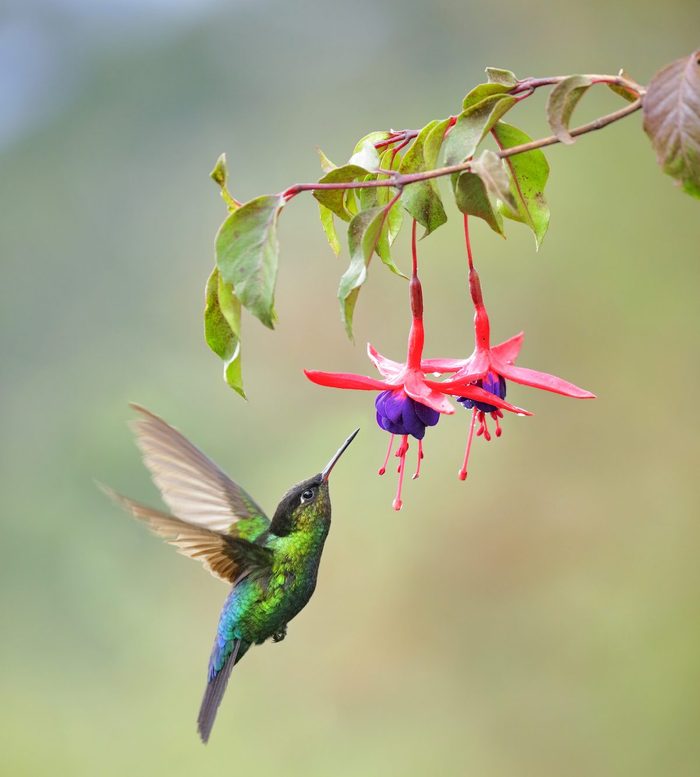
When seen in the shadows, it can look like the plainest of hummingbirds, just a dull green all over. But let the light hit it just right, and the fiery-throated truly lives up to its name. The throat feathers flash a bold mix of red, gold and bronze, with dashes of blue and purple on the head, chest and tail.
Fiery-throated hummingbirds are fairly common in mountainous forests that run the length of Costa Rica. These fliers aren’t seen anywhere else except parts of western Panama.
Psst—discover 5 secret hummingbird travel sites to visit.
Long-billed Hermit
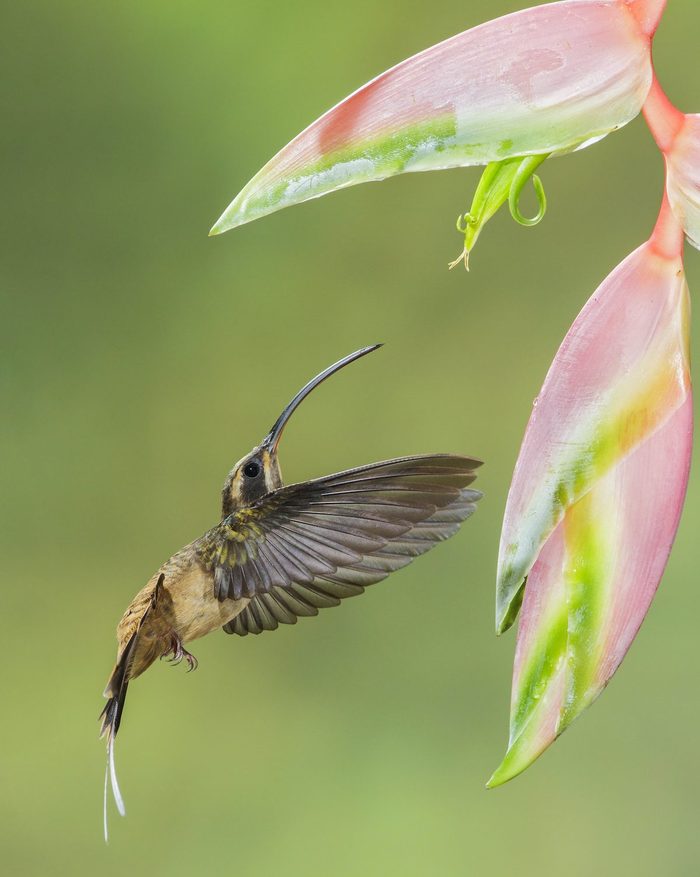
The hermits make up a group of medium-sized to large hummingbirds that live in the shaded forest interior. Most of them have long, curved bills and elongated central tail feathers. Several kinds live in Costa Rica, but the long-billed hermit is one of the most widespread, found in tropical forests throughout the lower elevations of the country.
Long-billed hermits can be tricky to observe. They move about inside the forest, visiting isolated flowers. Often they’re noticed first by their sharp, high-pitched call note as they zoom past, trailing their long white central tail feathers.
Purple-crowned Fairy
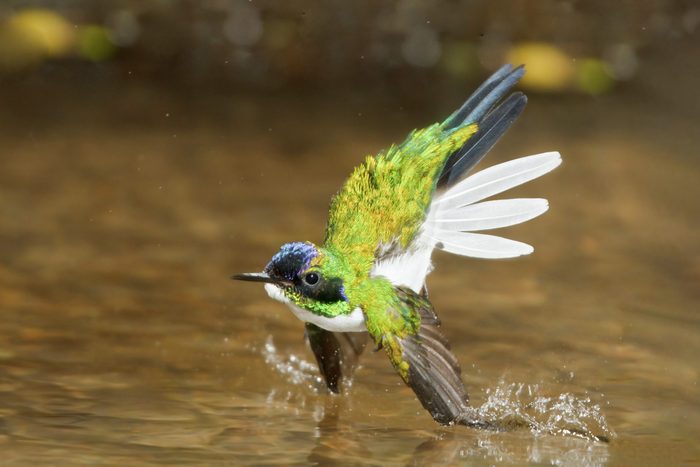
This large hummingbird often stays high, hovering around flowers in the mid to upper levels of trees at tropical forests’ edges in the valleys and lowlands. Fortunately it’s still easy to spot because it often spreads and flips its long tail while hovering, flashing the white outer tail feathers.
In addition to its tail pattern, identify this bird by the contrast between its bright white underparts and green back. The purple crown of the male is often hard to see.
White-crested Coquette
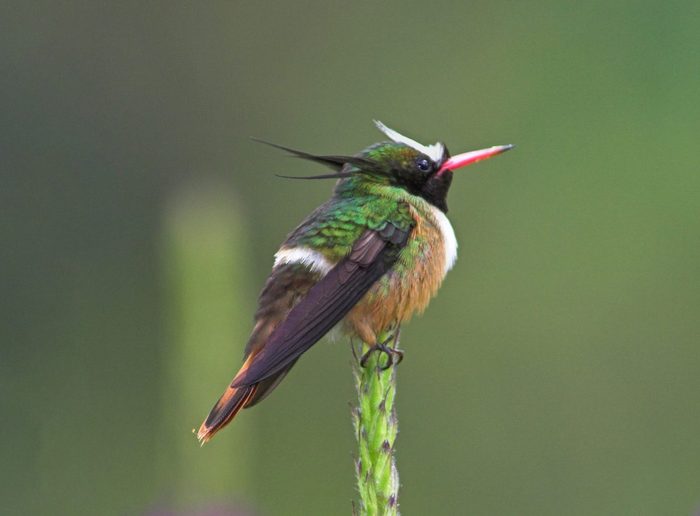
One of the most sought-after hummingbirds in Costa Rica, birders commonly spot the tiny white-crested coquette in the country’s southwestern lowlands. Green on the back and washed with orange on the belly, both males and females have a white band across the lower back. In addition, the male has narrow green plumes at the side of the throat and a perky white crest.
A former name for this species, “adorable coquette,” seems totally appropriate.
Meet the calliope hummingbird: the smallest bird in the U.S.
Rufous-tailed Hummingbird
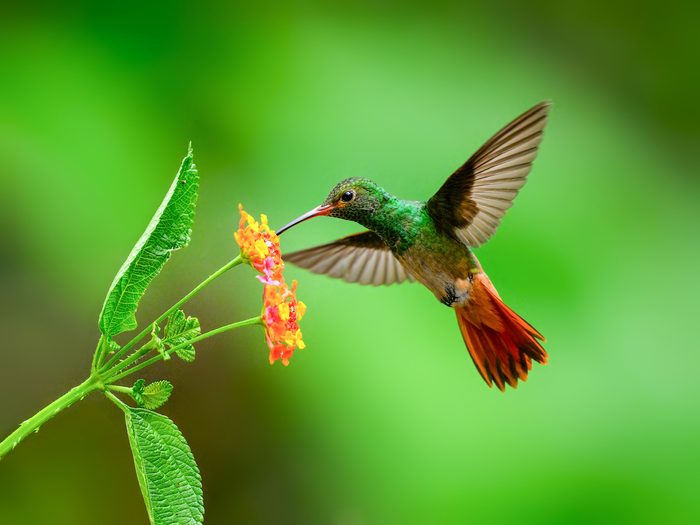
Probably the most common hummingbird in Costa Rica, the rufous-tailed is found almost everywhere at low to middle elevations. It thrives in dry scrub in the northwestern part of the country, in the edges of wet tropical forests, along roadsides, in suburban gardens, and even in the middle of the capital city of San Jose.
Aside from their bright reddish brown tails, adults are mostly bright pale green with red bills. The male often sings from a favorite high perch, giving a series of thin, high-pitched notes.
Snowcap
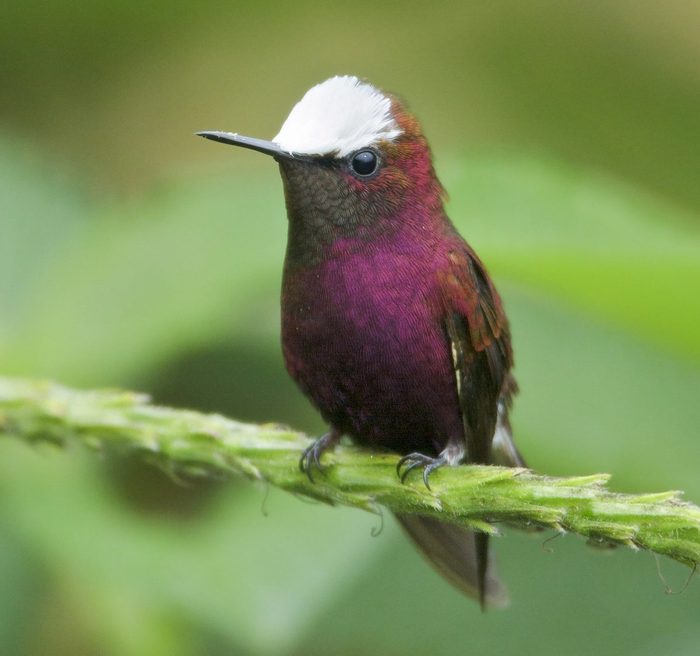
A unique little gem, the male snowcap is mostly a dark reddish or bronzy purple but with a bright white cap and white outer tail feathers. The female, with a green back and white underparts like many other hummingbirds, is less distinctive.
Snowcaps are found in four Central American countries, from Honduras to Panama. But they are seen most regularly in the foothills of Costa Rica.
Up to six male snowcaps may perch on exposed twigs at the edge of a clearing and sing a soft, rambling song to attract the attention of females.
Learn how to identify a broad-billed hummingbird.
Violet Sabrewing
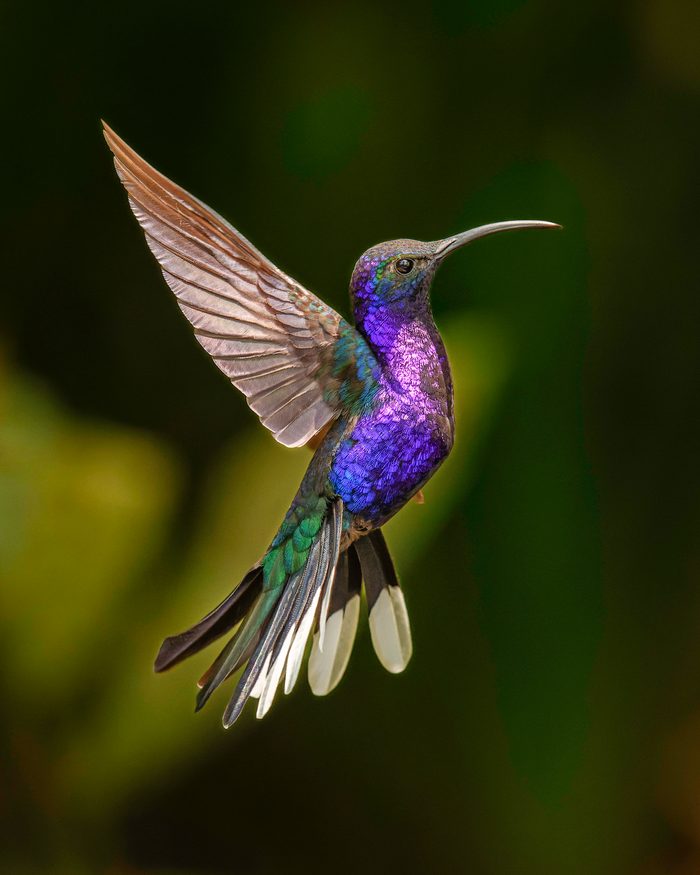
The male violet sabrewing is unmistakable: a large, dark hummingbird with mostly deep purple on the head and chest, green on the back and wings, long curved bill, and big white patches in the tail. The female is a little plainer, with purple only on the throat. But she has the same bill shape and bold white tail spots.
Violet sabrewings live in the foothills and mountains in Costa Rica, ranging through the understory and mid-levels of the forest.
What makes hummingbird feathers so shimmery?
Go Birding to See Costa Rica Hummingbirds

Although multiple species of hummingbirds can be found almost anywhere in Costa Rica, no single spot has them all. Each kind has their own habitat preferences. Some thrive in lowlands, some live in mountainous mid-level areas, and some are found mainly near higher peaks. To see a good variety, plan to go birding at different elevations.
Fortunately, in this small country, it’s easy to travel from low valleys to higher slopes in a short time. Costa Rica has many tourist lodges that cater to bird-watchers and naturalists. Many of these locations have gardens to attract hummingbirds. When planning a visit, ask ahead about these opportunities and facilities.
- Head to the mountains and stay at Paraiso Quetzal Lodge, a fantastic place to relax and see the many high-elevation species of hummingbirds found in Costa Rica. You may spot a fiery-throated hummingbird or lesser violetear.
- Put your eyes to the skies at Rancho Naturalista, a lodge located in the lush rainforest. The snowcap, a tiny purple hummingbird with a white cap on its head, stops by regularly.
- Grab a bite to eat and keep your eyes open for hummingbirds at a delightful roadside diner, Galeria de Colibries y Restaurant Cinchona. The back patio offers the best seats in the house. Bird-watch at the Virgen del Socorro canyon near the restaurant.
Why Trust Us
For nearly 30 years, Birds & Blooms, a Trusted Media Brand, has been inspiring readers to have a lifelong love of birding, gardening and nature. We are the #1 bird and garden magazine in North America and a trusted online resource for over 15 million outdoor enthusiasts annually. Our library of thousands of informative articles and how-tos has been written by trusted journalists and fact-checked by bird and garden experts for accuracy. In addition to our staff of experienced gardeners and bird-watchers, we hire individuals who have years of education and hands-on experience with birding, bird feeding, gardening, butterflies, bugs and more. Learn more about Birds & Blooms, our field editor program, and our submission guidelines.
On This Page
What Does a Broad-Billed Hummingbird Look Like?
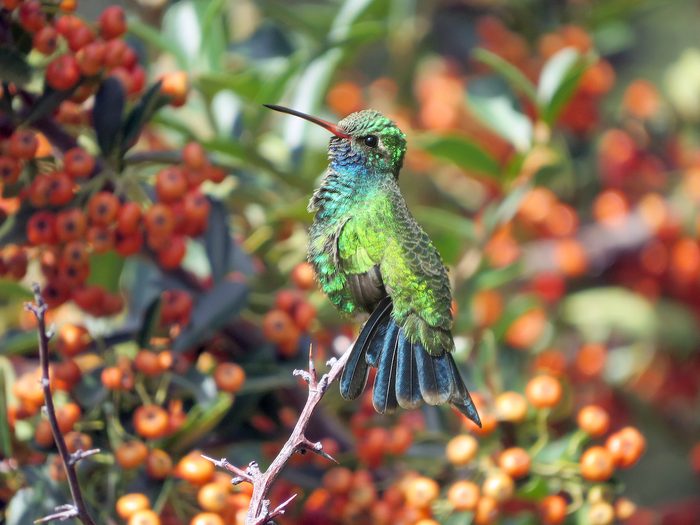
Even for hummingbirds, broad-billed hummingbirds are stunning little creatures. The males sport vibrant emerald bodies, iridescent sapphire throats and bright red bills tipped with black. The females deserve equal admiration with their sleek gray bodies and a distinct white line next to each eye.
“This is the wow hummingbird of North America,” says Dan Weisz, an expert naturalist, photographer and volunteer presenter at the Arizona-Sonora Desert Museum.
And they’re not all that hard to see most of the year as they flit from backyard feeders to their favorite native flowers.
Range and Habitat
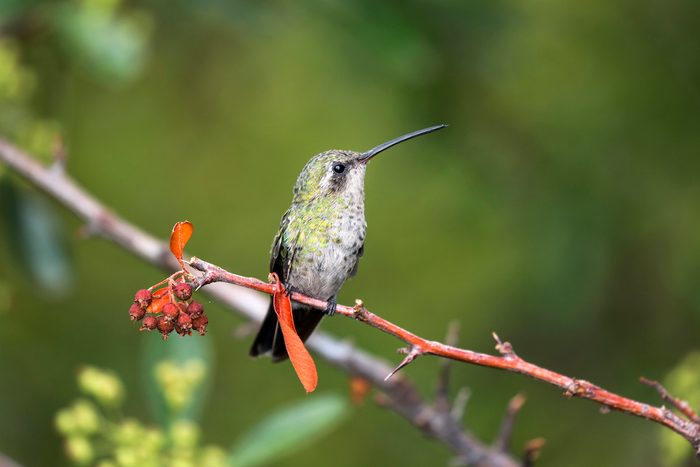
The broad-billed hummingbird lives predominantly in Mexico and southeastern Arizona. However, its range is expanding as more birds overwinter in the U.S.
They’ve also turned up in unexpected places such as California, Oregon and even the Great Lakes region. Two recent sightings in Colorado turned out to be birds originally banded in Louisiana, says Sheri Williamson, author of Peterson’s A Field Guide to Hummingbirds of North America.
“They have a penchant for wandering,” she says. “That can cause pretty thrilling responses when you look out your window.”
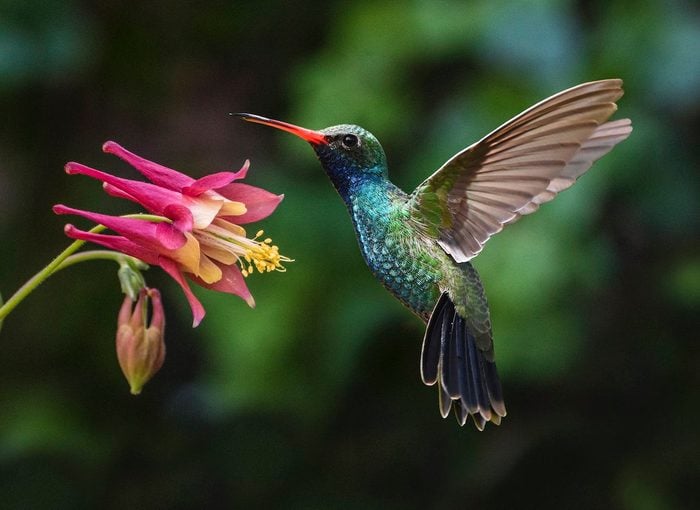
Dan suggests heading to the Tucson area in the spring, summer or fall for a chance to see these jeweled fliers. Visit the Paton Center for Hummingbirds and Santa Rita Lodge. Also look for the birds in lower foothills with thorny vegetation and oak trees.
Learn more about amazing Arizona hummingbirds (and the best places to see them).
Calls and Sounds
Bird sounds courtesy of the Cornell Lab of Ornithology
For Sheri, the broad-billed hummingbird is more than lovely feathers. It’s crafty, bold and curious.
During banding at the Southeastern Arizona Bird Observatory, the birds raise a ruckus when handled, but when released near food, they stand up and proudly look around. She’s even had one buzz over her head while flying back and forth to a backyard feeder.
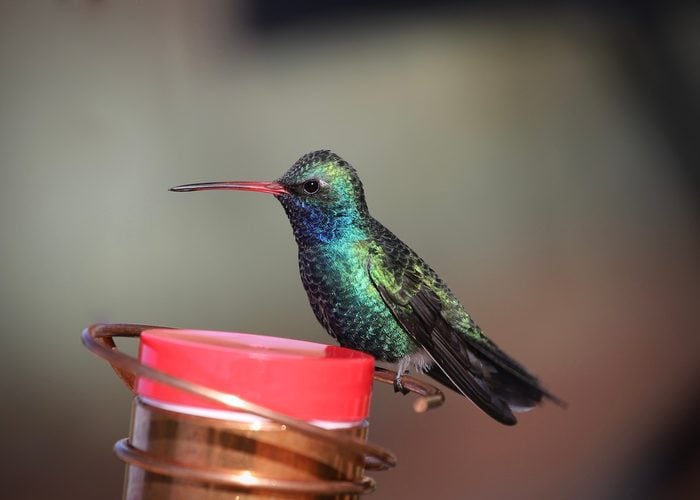
“He was letting me know the sugar water was not up to his standard,” Sheri says. “Even if broad-bills were the ugliest hummingbird on the planet, they would be fascinating because of their behavior and intelligence.”
Nesting Habits
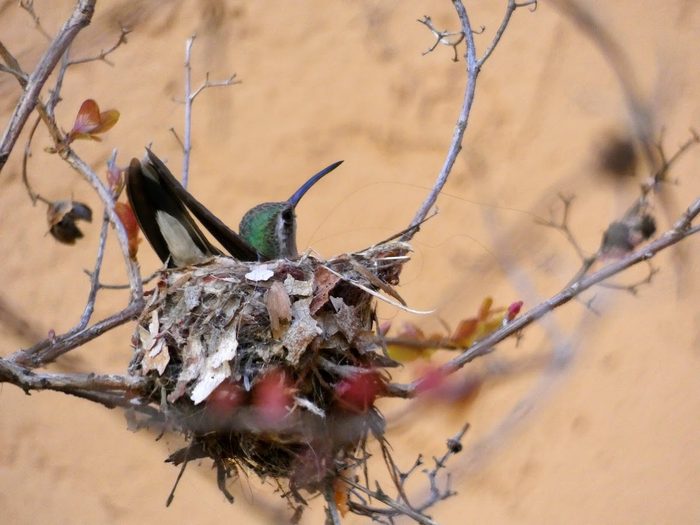
When it comes to attracting mates, these showy birds never needed to develop advanced aerial acrobatics like other hummingbirds, possibly because they’re so naturally flashy, according to Sheri. The males simply fly back and forth in front of females, singing along with their easy movements.
To avoid predation, the broad-billed hummingbird builds its nests on long, thin branches or in clusters of vines. “Then, snakes don’t have a whole lot to hang onto. They’re more likely to fall off before they actually get to where the eggs and babies are,” Sheri says.
Broad-bill nests are also uniquely deep, requiring the female to fold almost in half as she rests on her eggs. Even more intriguing, observers have noticed that females often build nests underneath or near hawks’ nests, possibly as a way to protect their babies from other predators.
Sheri’s take on this interesting partnership? “The enemy of my enemy is my friend,” she says.
About the Experts
A retired public school educator, Dan Weisz has been a volunteer presenter at the Arizona-Sonora Desert Museum for several years. He is a naturalist, photographer and birder.
Sheri Williamson is a naturalist, ornithologist, writer and public speaker. She is the author of A Field Guide to Hummingbirds of North America, part of the Peterson Field Guide series.
Sources
- Tucson Audubon
- Paton Center for Hummingbirds
- Santa Rita Lodge
- U.S. Forest Service
- National Audubon Society – broad-billed hummingbird
- All About Birds – Broad-billed hummingbird
Why Trust Us
For nearly 30 years, Birds & Blooms, a Trusted Media Brand, has been inspiring readers to have a lifelong love of birding, gardening and nature. We are the #1 bird and garden magazine in North America and a trusted online resource for over 15 million outdoor enthusiasts annually. Our library of thousands of informative articles and how-tos has been written by trusted journalists and fact-checked by bird and garden experts for accuracy. In addition to our staff of experienced gardeners and bird-watchers, we hire individuals who have years of education and hands-on experience with birding, bird feeding, gardening, butterflies, bugs and more. Learn more about Birds & Blooms, our field editor program, and our submission guidelines.
Sugar Crystal Double Tulips
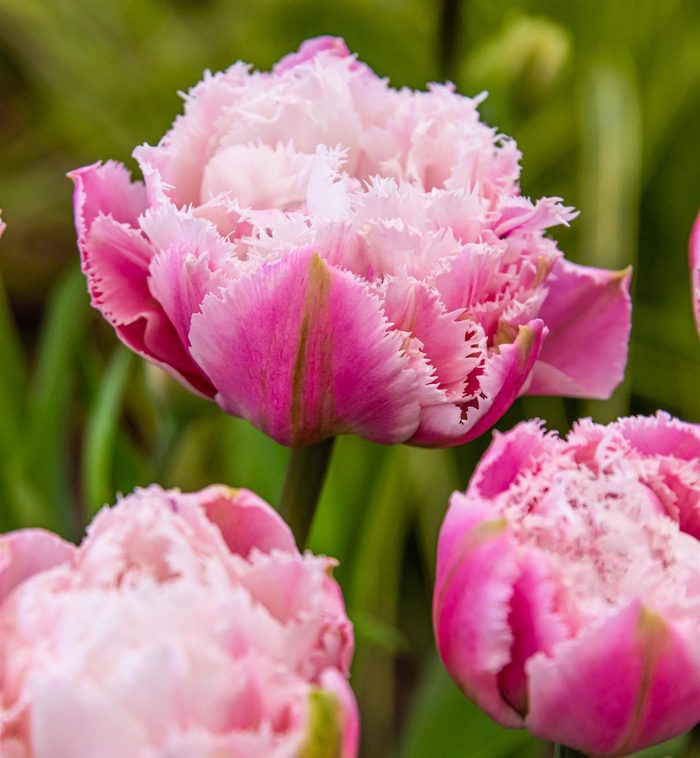
- Tulipa
- Zones 3 to 8
- Light needs: Full sun to part shade
- Size: 12 to 16 inches tall
- Bloom time: Mid to late spring
- Foliage: Light green and upright
- Soil: Well-draining
If you’re looking for head-turning tulip power, this plant’s double baby pink blooms are it. Look closely at the tulip’s feathery petal edges—they almost appear to have a silver tint to them. Like all tulips, Sugar Crystal likes to be in well-draining soil.
These gorgeous, textured blooms are ideal for cut-flower arrangements. While some tulips have floppy foliage, these
have stiff, upright foliage.
One word of caution: Tulips are deer candy. Keep deer away by following instructions on deer deterrents or repellents.
Check out the top 10 types of tulips to plant in your garden.
Fall Planting Guide for Double Tulips
Plan ahead for next spring by purchasing Sugar Crystal double tulip bulbs in time for fall. Plant them at least 6 inches deep and spaced about 6 inches apart.
Dave Dowling, cut flower specialist with Ball Seed says, “Home gardeners planting tulips should remember that tulips need soil that drains well. They should be in an area with full or part sun. Water the bulbs well when planting. They need a cold vernalization period after planting–usually 12 weeks of temperatures near or below freezing at night.”
Next, discover fascinating tulip facts you don’t know.
About the Expert
Dave Dowling is a cut flower specialist with Ball Seed company. He owned a cut flower farm in Maryland for 20 years and previously served as the Mid-Atlantic Regional Director of the Association of Specialty Cut Flower Growers.
Sources
- Ball Horticultural Company
- White Flower Farm
- Dutch Grown
Why Trust Us
For nearly 30 years, Birds & Blooms, a Trusted Media Brand, has been inspiring readers to have a lifelong love of birding, gardening and nature. We are the #1 bird and garden magazine in North America and a trusted online resource for over 15 million outdoor enthusiasts annually. Our library of thousands of informative articles and how-tos has been written by trusted journalists and fact-checked by bird and garden experts for accuracy. In addition to our staff of experienced gardeners and bird-watchers, we hire individuals who have years of education and hands-on experience with birding, bird feeding, gardening, butterflies, bugs and more. Learn more about Birds & Blooms, our field editor program, and our submission guidelines.
On This Page
Can Birds Improve Your Mental Health?
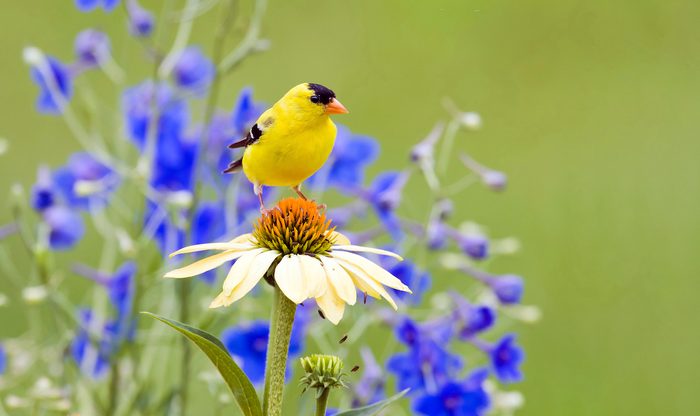
Cardinals, chickadees, juncos, woodpeckers … action! My feeders are full of life. I’ve been feeding birds since I was a little kid. But I only recently reflected on why I have kept feeding them for so many years.
Birds can find food on their own. I know their survival doesn’t depend on me, although I do hope my bird feeders help them in hard times. Personally, feeding birds makes my life better. Watching them right outside my window brings me reliable peace and joy. And there is research that shows watching birds boosts mental health.
Discover the mental and physical health benefits of gardening.
Finding Joy in Feeding Birds
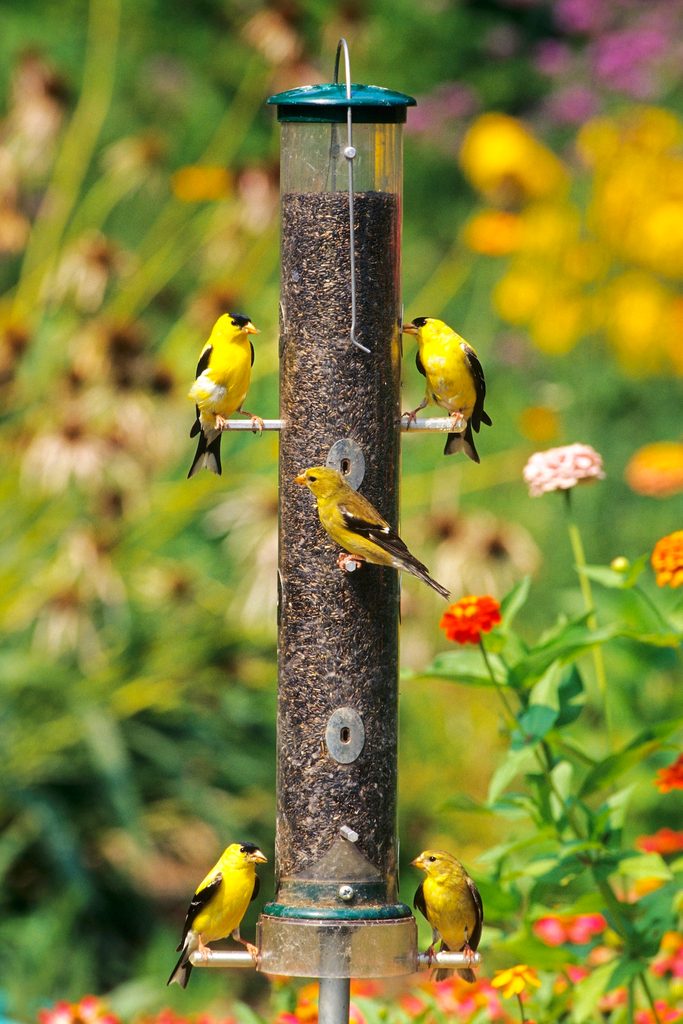
It’s such a simple way to improve my mental well-being. And it’s not just me. Feeding birds as a pastime exploded in popularity during the COVID-19 pandemic. A recent Audubon article described a measurable boom in birdseed sales that began then and continues today—evidence that bird feeding fulfills our human need for connection.
I was delighted to see that the Cornell Lab of Ornithology’s Project FeederWatch collects data on these benefits. Their current data entry portal includes two places for observers to rank the emotional states they experience while conducting monthly feeder surveys. I had no hesitation in giving my bird survey the happiest ranking available!
My friend, Alanna, posted a picture of her brand-new but still empty feeders on Facebook. She was worried because birds were not visiting them. I commented on the post, sharing perspective on being patient while her neighborhood birds discover her offerings. I then followed up with an email asking if she could tell me why she decided to start feeding at the start of 2024.
She responded: “As someone who struggles with anxiety, it can be almost debilitating to think about getting out of the house in pursuit of birding opportunities. Having an at-home bird feeder alleviates that anxiety.” I told her I also find observing birds boosts mental health.
The Healing Power of Nature
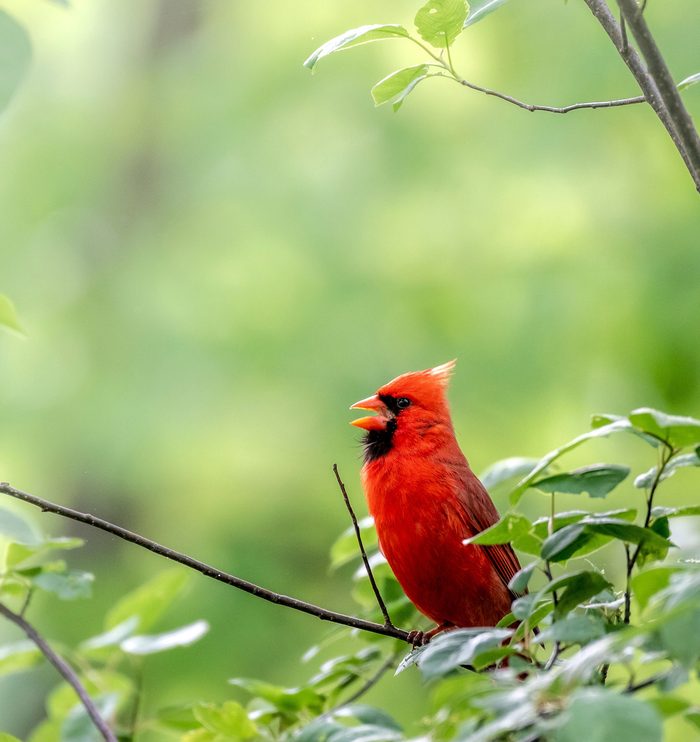
The number of books touting the positive effects of exposure to nature on mental health increases yearly. A quick search nets a flock of popular titles that reflect the underlying surge in academic studies combining interdisciplinary research from fields as far-flung as ecology, theology, psychology, medical science, urban planning, gardening and landscape architecture—well, the connections are seemingly endless.
But why is nature so healing? Two psychology professors at the University of Michigan, Rachel and Stephen Kaplan, found an answer through their research on two types of attention: directed attention and fascination. Because we spend much of our time in directed attention, focused on doing and thinking, they found this results in directed energy fatigue. And spending time in nature, a form of fascination, allows people to reset from task-driven fatigue.
If you see a cardinal, here’s what it means.
Building Resilience
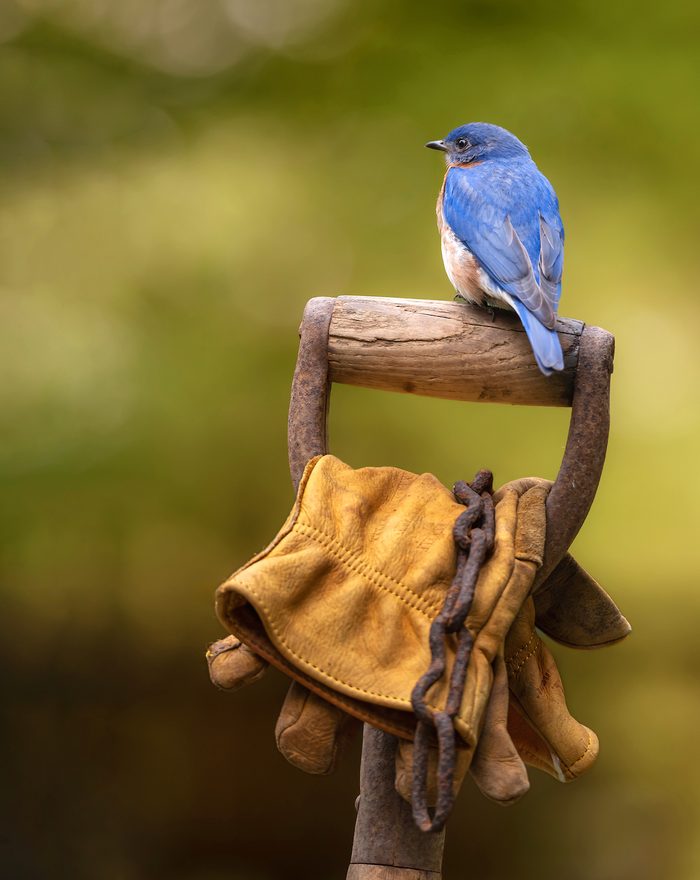
Following this same thread, Terry Hartig, a professor in the psychology department of Uppsala University in Sweden, conducted research on “restorative environments.” In particular, his research focused on how contact with nature can help build resilience in several areas of modern life.
Licensed therapist Tammah Watts first experienced the healing properties of bird-watching in the face of chronic pain. Eager to share her discoveries, she penned a how-to guide called Keep Looking Up, full of tips for connecting birds with mental and spiritual well-being.
And in one recent study, researchers directed more than 1,200 participants to use a smartphone app called Urban Mind to collect data on how they felt after hearing or seeing birds. Encouragingly, the results concluded that observing birds had positive effects on people with and without depression.
So it seems like the link between watching birds and mental health is not just wishful thinking—it’s a researched and documented subject of many scientific studies. More simply, think of watching your feeders as a little spa for your mind and spirit— and it’s one with unlimited visits.
Here’s to your mental health, and the well-being of your feeder birds!
Restorative Reflections
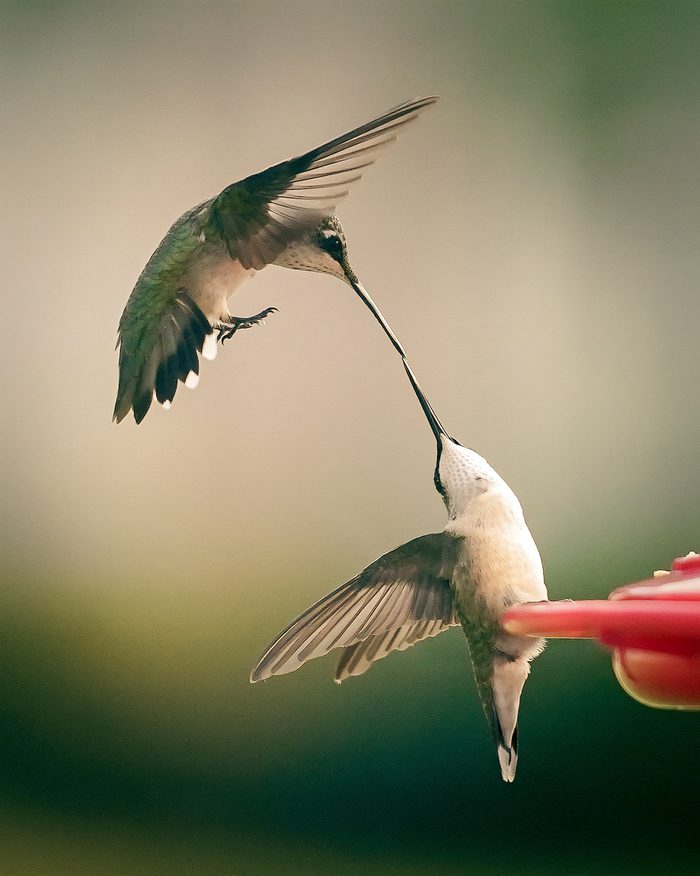
Here are four different ways I experience mental restoration with feeder-watching. This list may give you some ideas for your own experience.
- Birds pull me out of my worries and self-absorption. Looking at birds, even for an instant, I find respite from everyday worries and planning. I’m living in a restorative frame of mind when I revel in the brilliant scarlet of a cardinal.
- Birds mark the seasons. I look forward to a purple finch arriving from the North as much as I anticipate American goldfinches changing from drab beige to brilliant yellow in early spring. My feeder birds remind me of the resilience of life.
- Birds bring unexpected drama. Anticipation and excitement are therapeutic to me. A sharp-shinned hawk swoops in to study nearby birds, and I am caught up in the tension of the chase.
- Birds are poetry in motion: graceful movement, a palette of color, shapes, patterns and behaviors. The poet Emily Dickinson once wrote “Hope is the thing with feathers,” and it’s still true today.
Sources
- CHAAD – Spend Time Outside to Improve ADHD Symptoms
- American Psychological Association – Green Is Good for You
- Uppsala University – Nature-based biopsychosocial resilience
- Springer Nature – Restoration in Nature: Beyond the Conventional Narrative
- National Audubon Association
- Cornell Lab of Ornithology – Project FeederWatch
- Scientific Reports – Smartphone-based ecological momentary assessment reveals mental health benefits of birdlife
- Science Advances – Linking the nonmaterial dimensions of human-nature relations and human well-being through cultural ecosystem services
Why Trust Us
For nearly 30 years, Birds & Blooms, a Trusted Media Brand, has been inspiring readers to have a lifelong love of birding, gardening and nature. We are the #1 bird and garden magazine in North America and a trusted online resource for over 15 million outdoor enthusiasts annually. Our library of thousands of informative articles and how-tos has been written by trusted journalists and fact-checked by bird and garden experts for accuracy. In addition to our staff of experienced gardeners and bird-watchers, we hire individuals who have years of education and hands-on experience with birding, bird feeding, gardening, butterflies, bugs and more. Learn more about Birds & Blooms, our field editor program, and our submission guidelines.
On This Page
What Do Northern Saw-Whet Owls Look Like?
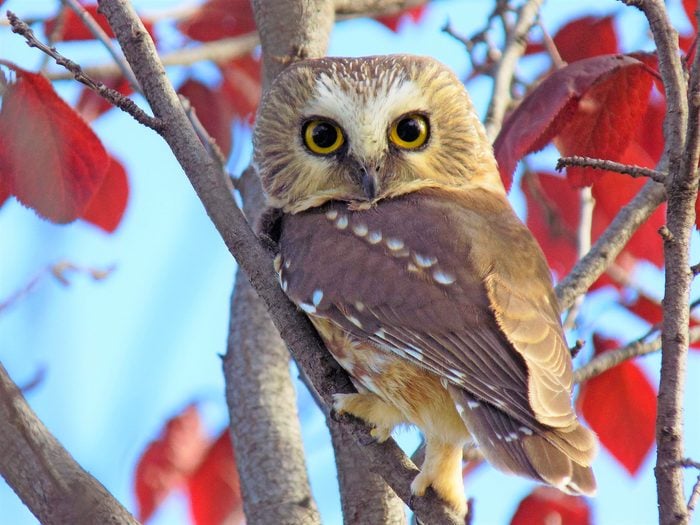
One of the cutest birds ever, (as voted on by Birds & Blooms readers) is the northern saw-whet owl, and Phil Brown, Bird Conservation Director at the Harris Center for Conservation Education in Hancock, New Hampshire, agrees. “They are one of the most charismatic species,” he says.
The micro sized owls stand around 8 inches tall, roughly the size of a robin. According to Phil, “saw-whets weigh about the same as a stick of butter.”
Although they are fairly common, saw-whets are highly nocturnal and rarely seen.
Round faces with oversized endearing yellow eyes add to their charm. Both males and females look the same with mottled brown plumage. Females are larger than males, but this is difficult to discern from field observations. Instead, biologists assess this with weights and wing measurements.
Age is another characteristic that researchers can determine. Phil says at owl banding stations, researchers shine blacklights on the wing feathers. Younger saw-whet owls shine pink due to higher amount of a chemical on the feathers that breaks down in sunlight. Older birds retain less of this porphyrin, so they are duller under the blacklights.
Discover the amazing types of owls in North America.
Range and Habitat
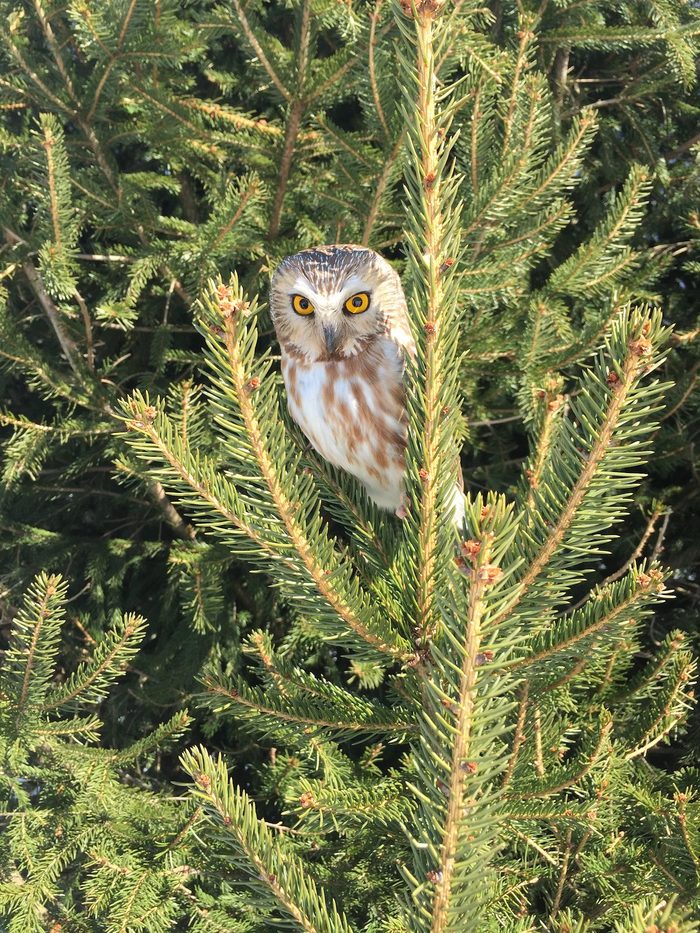
Northern saw-whet owls breed in the forests of Canada, and in the western mountains south through central Mexico. They also breed in the northeastern states and locally in the higher elevations of the Appalachians. In fall, saw-whet owls spread out from their breeding grounds. Winter range includes much of the Great Lakes, New England and parts of the Midwest. Southern states also see winter arrivals of saw-whets, but in more limited numbers.
Phil explains that “saw-whets have feathers all the way to their toes, an adaption for cold weather survival.”
A key to winter habitat is “dense thickets of conifer trees,” says Phil. Project Owlnet banding efforts like those at the Harris Center have helped researchers determine that not every owl migrates each winter.
The alarm notes of songbirds may draw your attention to a roosting saw-whet owl in dense conifer stands. The nocturnal owl is famously tame if approached, but if you come across one you should give it plenty of space as to not disturb the bird or reveal its location opening it up to harassment from other birds.
You might also see the elusive birds at a banding program as researchers continue to learn more about distribution patterns.
The National Audubon Society Climate Report predicts a 99% loss of current winter range by 2080. Northern saw-whets could be gone from the lower 48 states by the end of the 21st century.
Eastern vs western screech-owl: what’s the difference?
Nesting Habits
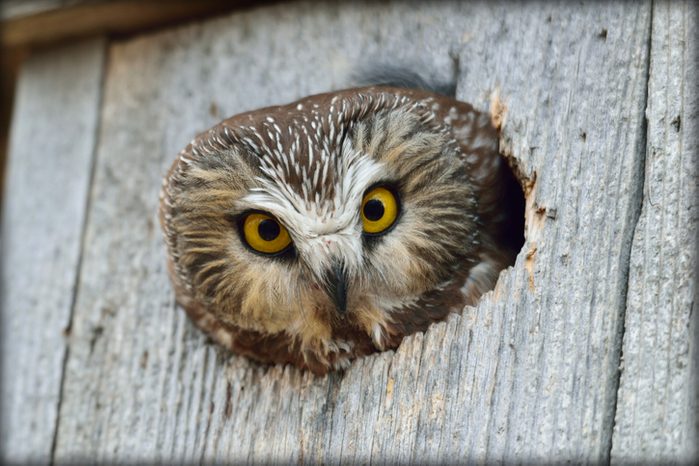
During courtship, female saw-whets will respond to the classic “too-too-too” call of males with a “tssst” call or repeated whistles. Males then circle the potential mate multiple times before perching nearby and presenting her with a prey item offering.
Northern saw-whet owls rely on cavities for nesting. “They are secondary cavity nesters,” say Phil, “so they rely on old woodpecker holes.” The species will use nest boxes when placed in appropriate mixed forest habitat, although they don’t generally return to the same cavity for nesting year after year.
Saw-whets tend to lay eggs on the existing debris in chosen cavities without building an entirely new nest. Females lay 4 to 7 smooth white eggs and incubate for nearly a month. Male saw-whets provide almost all of the food supply while the female owls incubate eggs and brood the young birds.
Learn how to attract owls to nest in your backyard.
Diet: What Do Northern Saw-Whet Owls Eat?
Despite their pint size, saw-whets are equipped with the same tools as the larger owls. “They have tiny, hooked raptor bills and sharp talons for killing,” says Phil.
Northern saw-whet owls will eat a variety of flying things including insects, bats, and songbirds, but their main food source is rodents. “They are small mammal generalists,” says Phil.
Every 4 years or so, as small mammal populations surge, saw-whets have a population boost as many young birds survive. These years also show a strong migration push, says Phil.
Larger prey items will be split up into multiple meals. The leftovers are sometimes stashed in tree cavity cupboards.
As with other raptors, rodenticides are a concern for saw-whet owls. The toxins accumulate in the owls if they eat rodents that have been exposed to the poisons.
Did you know: the elf owl is the smallest owl in the world.
Call and Sound
Bird sounds courtesy of the Cornell Lab of Ornithology
Despite being named after the sound of sharpening blades on whetstones, the tiny northern saw-whet owl’s charming, toot-toot calls are hardly menacing.
“They sound like the high-pitched beeps as a truck is backing up,” say Phil. He continues, that saw-whet owls make a variety of other noises including “high pitched squeaks, squawks, and whistles that are often confused with flying squirrel noises.”
Do owl sightings have special meaning?
About the Expert
Phil Brown (he/him) spent his childhood in Staten Island, New York, where he was fascinated with the natural world, especially the birds that passed through his suburban backyard. After undergraduate studies at Rutgers University, he pursued a career in natural resource management. Currently he serves as the Bird Conservation Director for the Harris Center for Conservation Education in Hancock, New Hampshire.
Sources
- National Audubon Society
- Cornell Lab of Ornithology
On This Page
What Does a Wood Thrush Look Like?
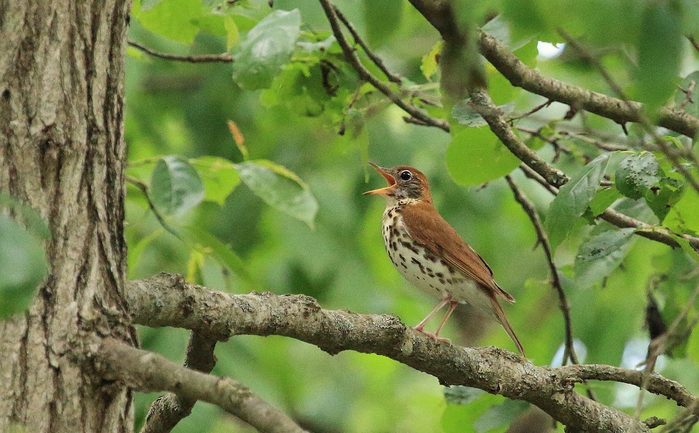
There are very few birds with songs that can rival the dreamy notes and complex trills of the wood thrush. These forest-dwelling birds can be hard to spot. Their field markings give them great camouflage that allows them to blend in with their surroundings.
“Most often you’ll hear them and not see them,” says Zach Ladin, an ecologist for U.S. Fish and Wildlife Service. Thrush species, including wood thrush, are known for their dreamy, flute-like song and complex trills. “For this reason, identifying wood thrushes by their song is a great method,” Zach says.
But if you are on the search, it’s easiest to spot them on the ground. Wood thrushes are medium-sized birds and larger than other thrush species, like hermit and Swainson’s thrushes. Both male and female wood thrushes have dark, bold spots on their chests and rich, cinnamon coloring on their backs and heads. Their large eyes help them spot bugs in thick, shady forests.
Learn to identify more small brown birds you might see.
Wood Thrush Habitat and Range
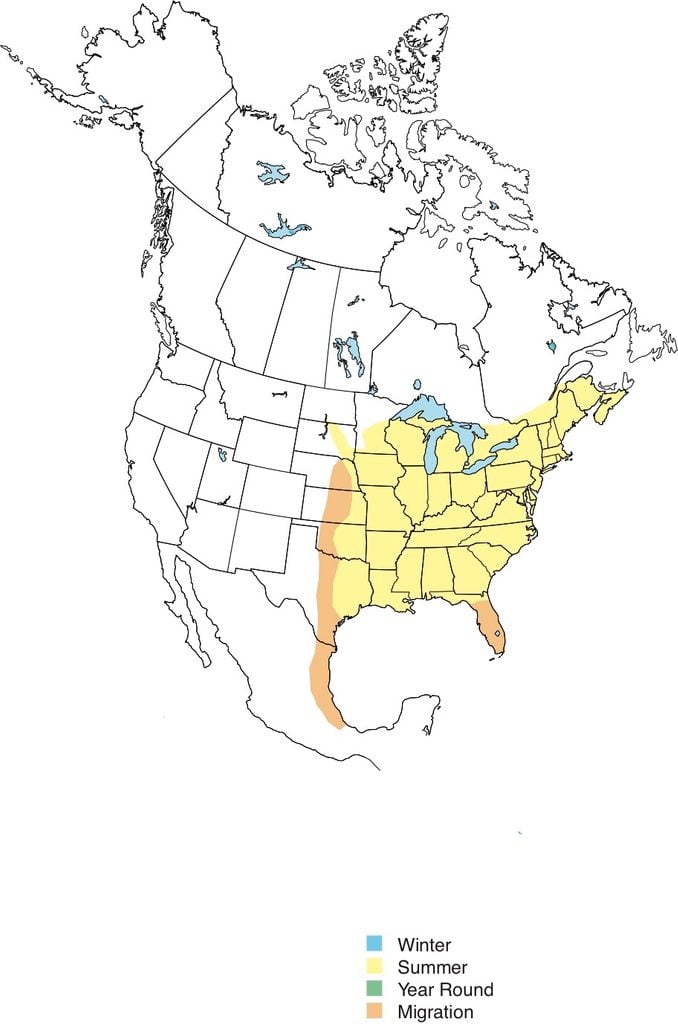
Range maps provided by Kaufman Field Guides, the official field guide of Birds & Blooms.
Wood thrushes live in the Midwest and eastern U.S. and stick to deciduous and mixed forests with dense undergrowth during their breeding season from May to August. When the weather gets colder, they head south to Central America.
Although wood thrushes are considered a common bird, their numbers have been declining since the 1950s due to loss of habitat and forest fragmentation.
“When forest habitat is reduced, there may be less food available and an increase in negative effects from predators and nest parasitism from brown-headed cowbirds,” says Zach. “We must take a holistic approach and work with international partners to protect habitats. We can protect those areas for birds and protect critical ecosystems that support life on Earth for humans — it’s a win-win.”
Learn how to identify a varied thrush.
Nesting Habits
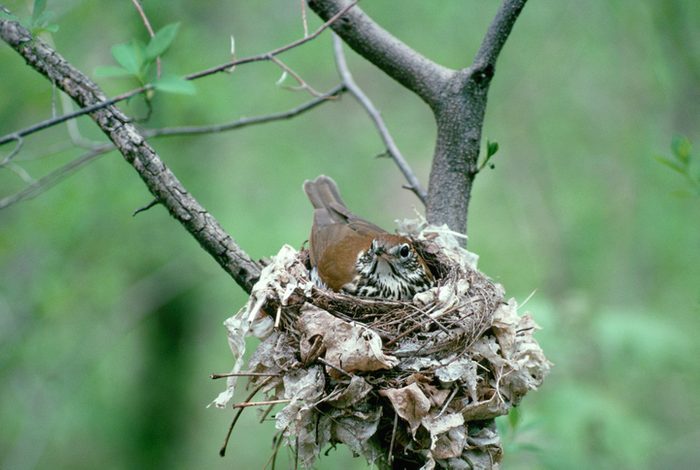
“Wood thrushes tend to build their nests in the forks of branches of understory shrubs or young trees,” says Zach. “On average, nest height is around 13 feet high but can range between two feet and over 90 feet from the ground.” The male finds and establishes the breeding ground. After courtship activities, like mutual feeding, the female selects the nest site.
Their nests are cup-shaped and lined with leaves, grass and, similar to American robins, a layer of mud. Sometimes they incorporate manmade materials, like cellophane and bits of paper, into the nest structure, too. Each nest holds three to four eggs.
A pair of wood thrushes will usually raise two broods per season in two separate nests. (Both parents feed the fledglings at first, and then the male continues feeding them after the female lays her next clutch of eggs.) Although wood thrush pairs raise their young together, they’re not monogamous. It’s relatively common for fledglings in a single brood not to share the same father.
One of the biggest challenges wood thrushes face during breeding season is contending with brown-headed cowbirds. This has been made worse by loss of habitat. “In a long-term study we conducted on wood thrushes in a fragmented landscape in Delaware, we found that despite having plenty of high-quality food, wood thrushes were negatively affected by brown-headed cowbirds, which lay their eggs in wood thrush nests,” Zach says.
Caring for and feeding the young cowbirds takes up the energy and time of the parent wood thrushes often at the fatal expense of their own young.
Diet: What Does a Wood Thrush Eat?
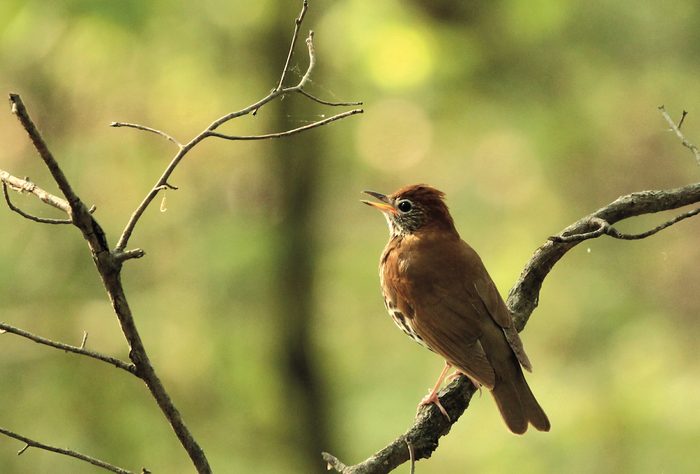
Wood thrushes hop along the forest floor and hunt for insects in the soil and under leaves. “They often forage in the leaf litter for invertebrates including snails and spiders,” says Zach. The shells of snails are an important source of calcium for female wood thrushes during breeding season. Small fruits and berries are also important items on the wood thrush menu, especially in late summer when they are preparing to migrate south.
However, if you’re hoping to attract wood thrushes to your backyard, you’re facing an uphill battle. “Wood thrushes are not your typical backyard bird, because they prefer mature forests with moderate understory vegetation,” says Zach. “But if you live on the edge of a forest or forest patch in the eastern U.S., you may have wood thrushes nearby during the breeding season.”
Wood Thrush Song
Bird sounds courtesy of the Cornell Lab of Ornithology
This species’ recognizable song is usually written out as ee-oh-lay but there’s a lot of complexity behind it. “Wood thrushes belong to a group of related thrush species that are known for having some of the most extraordinary songs in the bird world,” says Zach. “By passing wind through both sides of its vocal organ, called a syrinx, a wood thrush can generate its beautiful song with many overtones to create a rich, harmonic sound.” Essentially, it’s as though the bird is singing a duet with itself.
Because of all the different pitch and note variations available to these birds, a single male may sing up to 50 distinct versions of its song.
About the Expert
Zach Ladin is an ecologist who works in the Division of Migratory Birds in the U.S. Fish and Wildlife Service. He’s passionate about integrating ecological data and novel technologies to inform how humans can promote ecosystem health and function in light of increasing rates of global urbanization and climate change.
Sources
- National Geographic Backyard Guide to the Birds of North America: Jonathan Alderfer and Paul Hess
- All About Birds
- National Audubon Society
- American Bird Conservancy
- Smithsonian’s National Zoo & Conservation Biology Institute
Why Trust Us
For nearly 30 years, Birds & Blooms, a Trusted Media Brand, has been inspiring readers to have a lifelong love of birding, gardening and nature. We are the #1 bird and garden magazine in North America and a trusted online resource for over 15 million outdoor enthusiasts annually. Our library of thousands of informative articles and how-tos has been written by trusted journalists and fact-checked by bird and garden experts for accuracy. In addition to our staff of experienced gardeners and bird-watchers, we hire individuals who have years of education and hands-on experience with birding, bird feeding, gardening, butterflies, bugs and more. Learn more about Birds & Blooms, our field editor program, and our submission guidelines.
On This Page
What Does an American Redstart Look Like?
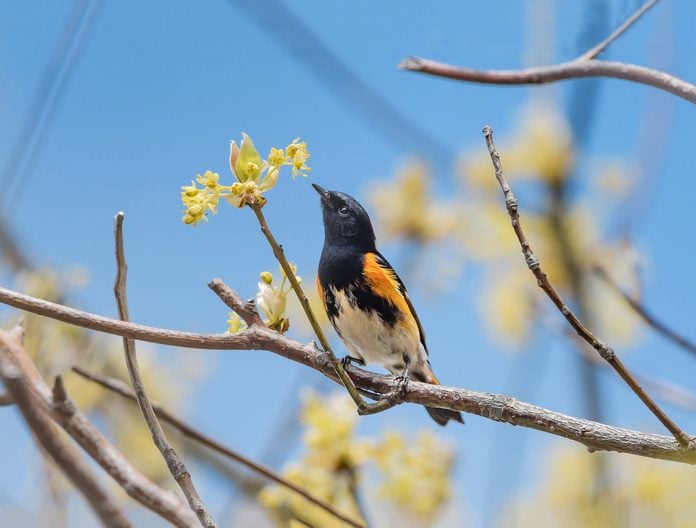
Bright yellow plumage is common among warblers, but the vibrant American redstart is distinctive. Males are mostly black, but bright orange patches on their sides, wings and tails help them stand out from leafy foliage.
“A lot of warblers can be tricky because they resemble other warblers, but there’s nothing like redstarts,” says Bill Rowe, president of St. Louis Audubon Society. “They’re immediately recognizable. The adult males, especially, but the females, too.”
Females have a more muted color scheme—their gray heads and dark wings are less eye-catching than the colors of their mate. Females have a patch of yellow on their sides, and a muddy yellow coloring extends to their tail and wings.
American Redstart Behavior
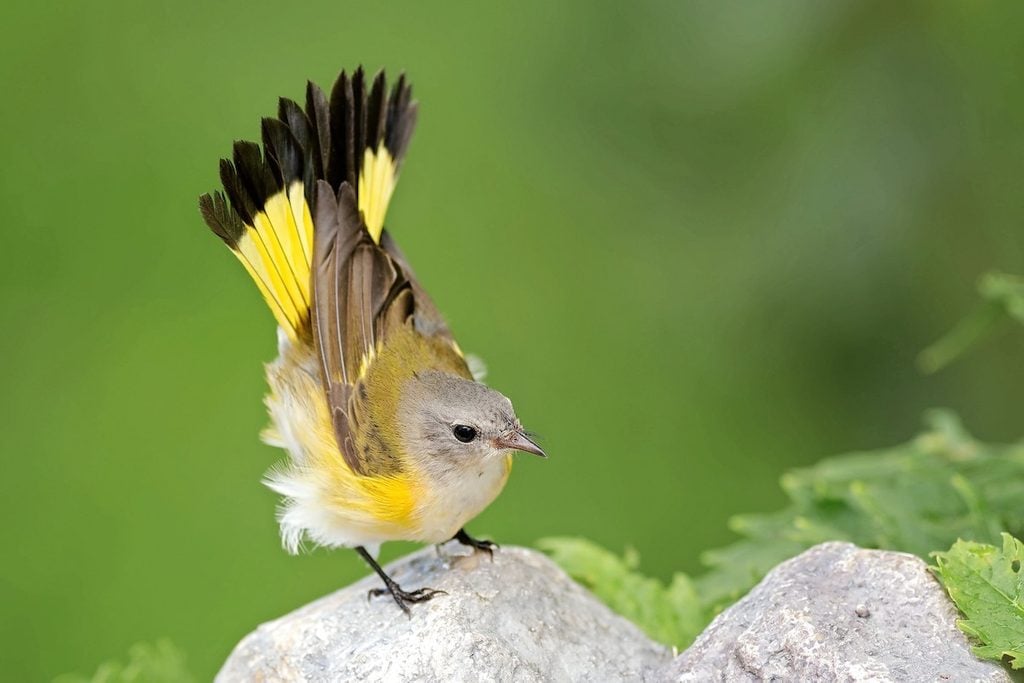
Redstarts are among the most active warblers. As a notable behavioral quirk, they tend to fan out their tails as they move, which makes them easy to identify.
“Theoretically, they do that to flush insects out so they can catch them in flight,” explains Dr. Kevin McGowan, senior course developer for the Cornell Lab of Ornithology’s Bird Academy. “They do a lot of fly-catching, so they’re trying to frighten the insects that are hiding into revealing themselves by flying away.”
Discover more fascinating facts about warblers.
American Redstart Habitat and Range
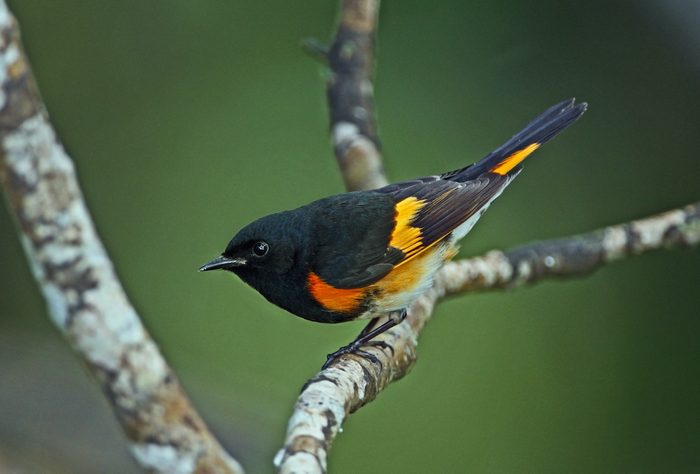
If you’re birding in spring on the edges of eastern forests, be sure to look for redstarts. While they migrate through much of the United States (with the exception of California), they remain for breeding season in the Midwest, Northeast, and a few Southern states such as Alabama and Louisiana.
Redstarts, like many warblers, prefer a forest habitat. In some sections of their range, birders can find them in woods along rivers or even in orchards.
“They’re one of the easiest [warblers] to observe,” says Bill. “Partly because they’re common, but also because many warblers are either high up in the trees most of the time, or they’re hiding in shrubbery. Redstarts like to hang out in somewhat open areas, where they will flit around and hunt for food.”
Learn how to identify yellow-rumped warblers.
American Redstart Diet
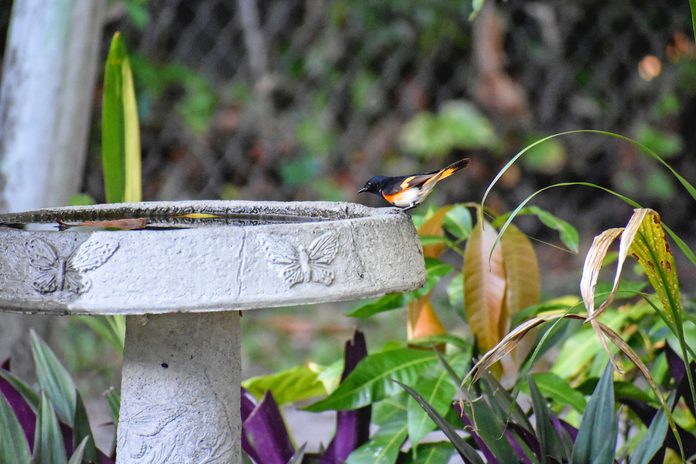
Like most warblers, redstarts usually aren’t interested in bird feeders. Primarily eating bugs, they’re known to dine on flies, moths, beetles, and other insects. They’ll also eat berries from time to time, especially barberry, serviceberry, and magnolia.
Unlike common songbirds, they don’t eat seed—but you might be able to attract warblers into your yard with a bird bath.
Bill says that if you live in the redstart’s migrating range and preferred habitat, all you really need to do is go outside and birdwatch in your yard. “Sooner or later, you’ll see one of the groups of migrants,” he says. “It varies day by day. Watch for movement in the trees.”
Yellow warbler vs goldfinch: learn how to tell the difference.
Nest and Eggs
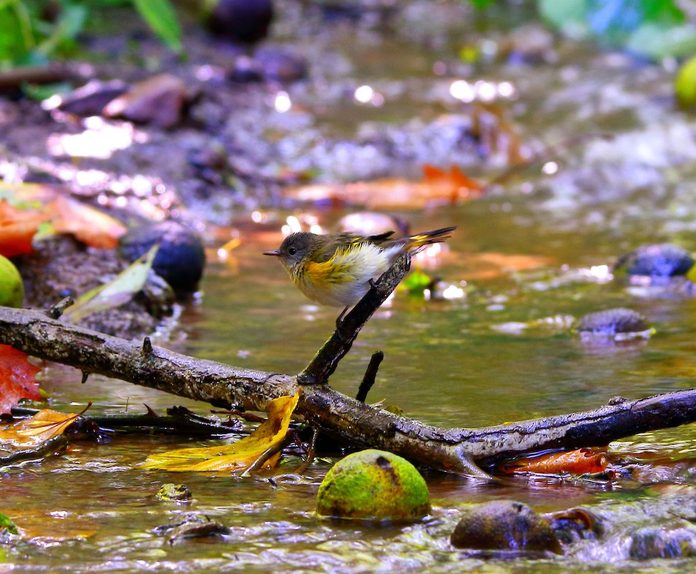
After constructing a nest, a female redstart lays a clutch of one to five eggs. She incubates the eggs for up to two weeks, and young birds remain in the nest for up to two weeks more. The male and female both take part in feeding the fledglings.
“The first-year males look like females,” Kevin says. “When they come back in the spring, they will sing and try to attract a mate, and it looks like a female that’s singing, but it’s actually a male. They get adult plumage the second year.”
Attract a prothonotary warbler with a birdhouse
American Redstart Song
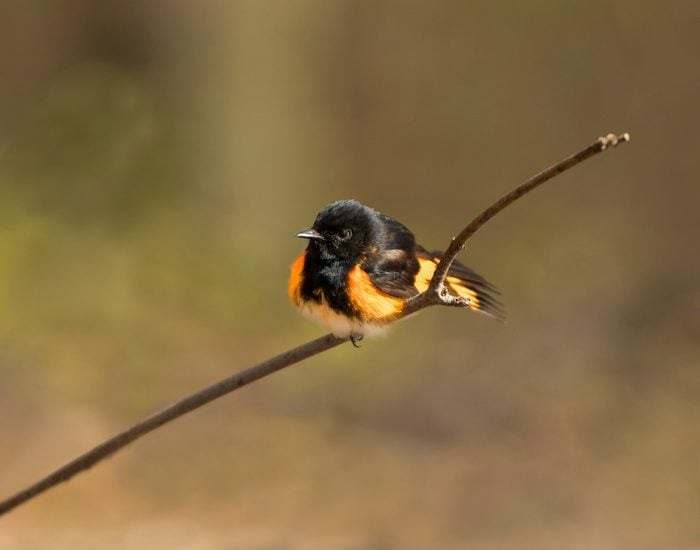
This warbler’s high-pitched, variable song often ends in a sharp shew. Some birders compare the sound to a sneeze.
Bird songs courtesy of the Cornell Lab of Ornithology.
Want to learn more about warblers? Meet the magnolia warbler and black-and-white warbler.
About the Experts
Lifelong birder and ornithologist Dr. Kevin McGowan is a senior course developer for the Cornell Lab of Ornithology’s Bird Academy. He earned a Ph.D in biology at the University of South Florida.
Bill Rowe is the president of St. Louis Audubon Society. Throughout his many years of volunteering and serving on the Board, he has written “Bird of the Week” columns, led field trips and private birding tours, and taught birding classes.
Sources
Why Trust Us
For nearly 30 years, Birds & Blooms, a Trusted Media Brand, has been inspiring readers to have a lifelong love of birding, gardening and nature. We are the #1 bird and garden magazine in North America and a trusted online resource for over 15 million outdoor enthusiasts annually. Our library of thousands of informative articles and how-tos has been written by trusted journalists and fact-checked by bird and garden experts for accuracy. In addition to our staff of experienced gardeners and bird-watchers, we hire individuals who have years of education and hands-on experience with birding, bird feeding, gardening, butterflies, bugs and more. Learn more about Birds & Blooms, our field editor program, and our submission guidelines.
On This Page
Collect Milkweed Seeds From Pods
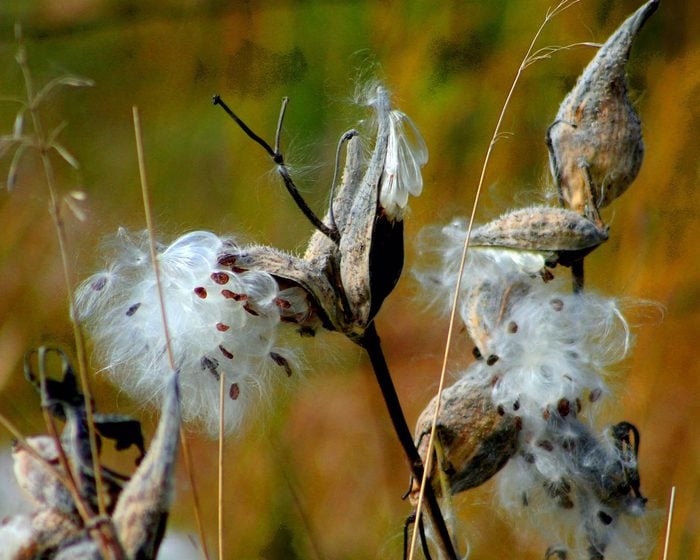
“I collected some dried pods from common milkweed last year. What’s the best way and time to plant the seeds from the milkweed pods?” asks Birds & Blooms reader Judy Roberts.
Horticulture expert Melinda Myers says, It’s hard to believe a plant that readily starts from seed in nature can be challenging for us to do the same. Before planting milkweed, keep in mind that common milkweed quickly forms colonies and can overrun a garden. Others, such as butterfly weed and swamp milkweed, are less aggressive and still support monarch butterflies.”
The seeds must be mature to sprout, so collect seeds just before or as the pods split open after the flowers stop blooming. Melinda says, “Start by removing any seeds remaining in the pods, saving only rich brown seeds that are mature and viable. It’s best to separate seeds from the white fluff, called coma, before drying and storing. You can do this by holding the seeds while in the pod and pulling off the fluff, rubbing the seeds between the palms of your hands or placing them in a paper bag and shaking vigorously.”
You could also consider tying small bags over the milkweed pods while they mature, since many distribute their seeds far and wide (especially common milkweed).
“After the pods on my milkweed plants open, I take the seeds and shake them into envelopes that I’ve labeled with the year the seeds were collected,” says reader Patrick Hogan.
Is tropical milkweed bad for monarchs? Is honeyvine milkweed invasive? Here’s what you need to know.
Milkweed Seed Cold Stratification
You will need to store seeds in the refrigerator or an airtight container in a cold place for several months. This cold treatment is needed to end dormancy and increase sprouting success.
Melinda recommends, “Next, store the dry seeds in an airtight container in the refrigerator until you are ready to process them for planting. Provide seeds with cold, moist stratification to break dormancy right before planting. Place the seeds in a damp paper towel inside a plastic bag, or with sand or vermiculite in a container. Put in the refrigerator for at least 30 days.”
Check out even more of the best types of milkweed to support monarch butterflies.
When to Plant Milkweed Seeds
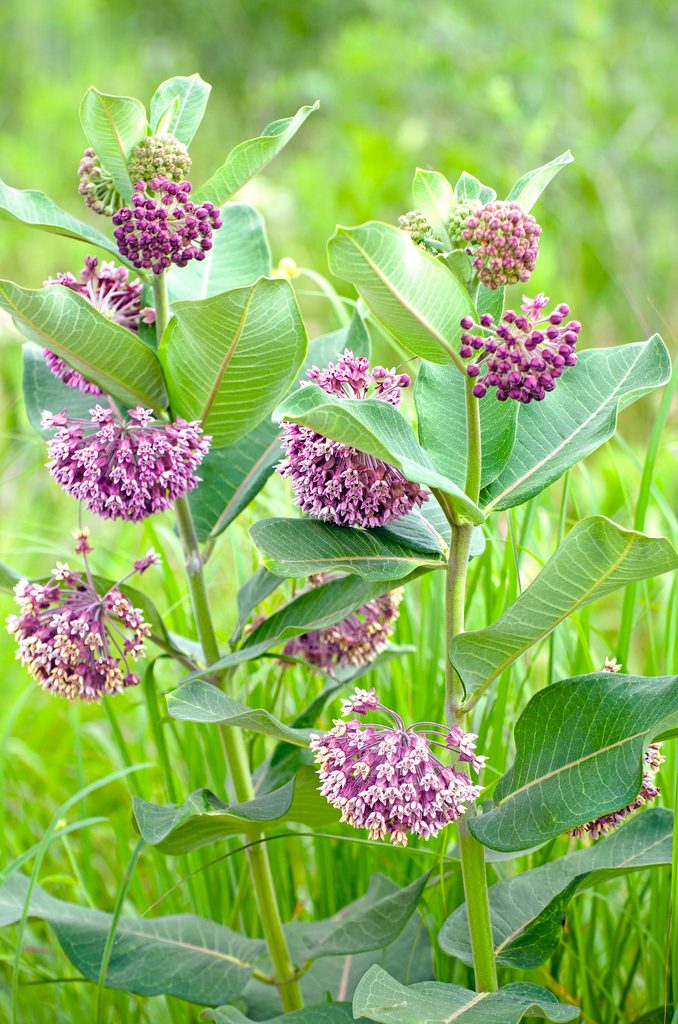
Melinda says, “Once stratified, you can start the seeds indoors or plant them directly in the garden after the last spring frost. Or let nature do the work with winter sowing. Look up instructions online for converting a plastic milk jug into a vessel for starting these and other seeds outdoors. In the future, consider mimicking nature and planting the seeds directly in the garden during fall.”
If it’s possible, start your seeds indoors under artificial lights in a quality potting or seed-starting mix. The seedlings will be ready to transplant in the garden once they are 3 to 6 inches tall and when the threat of the last spring frost has passed. Plan for about four to eight weeks of indoor growing time.
You can also plant seeds directly outdoors. Fall is the best time to direct-sow the seeds for gardeners in cold climates. Many milkweed varieties contain hard coatings that have to break down before the seeds will germinate. Exposure to a winter’s worth of snow and cold, wet weather will do just that.
Check out the Monarch Joint Venture for more information on how to collect seeds from milkweed pods. To order seeds, contact the Live Monarch foundation.
Next, learn how to get rid of aphids on milkweed plants.
About the Expert
Melinda Myers is the official gardening expert for Birds & Blooms. She is a TV/radio host, author and columnist who has written more than 20 gardening books. Melinda earned a master’s degree in horticulture from the University of Wisconsin-Madison.
Sources
- Monarch Joint Venture
- Live Monarch Foundation
Why Trust Us
For nearly 30 years, Birds & Blooms, a Trusted Media Brand, has been inspiring readers to have a lifelong love of birding, gardening and nature. We are the #1 bird and garden magazine in North America and a trusted online resource for over 15 million outdoor enthusiasts annually. Our library of thousands of informative articles and how-tos has been written by trusted journalists and fact-checked by bird and garden experts for accuracy. In addition to our staff of experienced gardeners and bird-watchers, we hire individuals who have years of education and hands-on experience with birding, bird feeding, gardening, butterflies, bugs and more. Learn more about Birds & Blooms, our field editor program, and our submission guidelines.